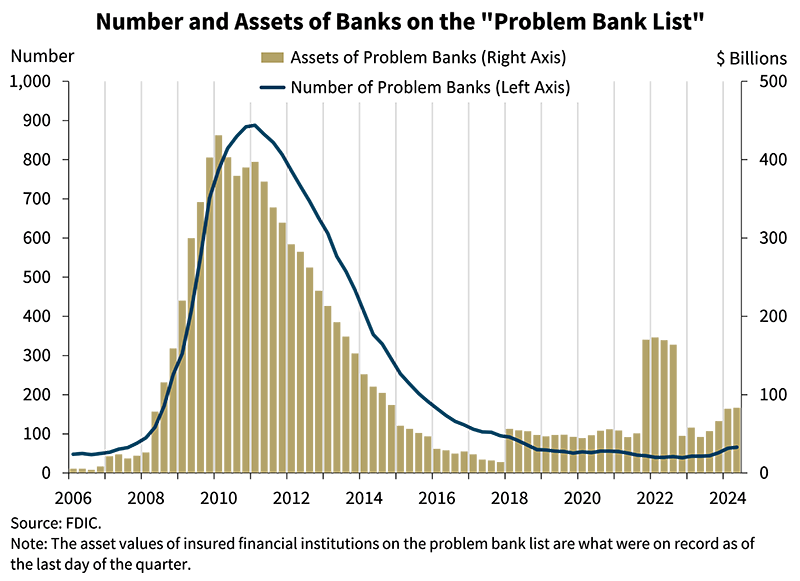According to the Federal Deposit Insurance Corporation (FDIC), the number of U.S. banks in serious trouble is increasing.
The quarterly bank profile for the second quarter of 2024 shows that the number of lenders on the “Problem Banks List” has increased quarter-on-quarter from 63 to 66.
It is the fifth consecutive quarterly increase for banks rated 4 or 5 on the CAMELS rating system since the second quarter of 2023.
A rating of 4 on the CAMELS system indicates that a bank is experiencing financial, operational or managerial problems that could reasonably jeopardize its viability if not resolved, while a rating of 5 indicates that a bank is seriously deficient and immediate remedial action required.
“The number of problem banks represents 1.5% of the total number of banks, which is within the normal range for non-crisis periods of 1% to 2% of all banks. Total assets of troubled banks increased by $1.3 billion to $83.4 billion.”

Meanwhile, U.S. banks continue to saddle billions of dollars in unrealized losses on securities. The FDIC reports a total of $512.9 billion in unrealized losses in the second quarter, down 0.7% quarter-over-quarter.
Says FDIC Chairman Martin Gruenberg:
“Interest rates rose modestly in the second quarter, putting downward pressure on bond prices, but the resulting increase in unrealized losses was more than offset by bond sales by several major banks, which resulted in significant realized losses.
This is the tenth consecutive quarter that the industry has reported unusually high unrealized losses since the Federal Reserve began raising rates in the first quarter of 2022.”
The dangers of unrealized losses came into focus last year during the collapse of Silicon Valley Bank, when concerns about the lender’s balance sheet triggered a bank run.
Today, Gruenberg says the U.S. banking sector continues to show resilience, but risks still exist.
“…The industry continues to face significant downside risks due to uncertainty in the economic outlook, market interest rates and geopolitical events. These issues could cause credit quality, earnings and liquidity issues for the sector.
In addition, weakness in certain loan portfolios, particularly office properties, credit cards and multifamily loans, continues to warrant monitoring. These issues, along with funding and margin pressures, will remain issues of continued FDIC supervisory attention.”
Don’t miss a beat – Subscribe to receive email alerts straight to your inbox
Check price action
Follow us further XFacebook and Telegram
Surf to the Daily Hodl mix
Generated image: Midjourney

